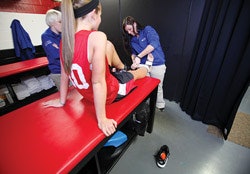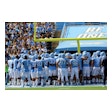Athletic trainer Jodie Smith has logged more than 2,500 miles in a single month, traveling between eight schools in and around Billings, Mont. Seven of those schools are K-12 facilities, with the number of high school students at each one ranging from 21 to almost 300. ...

Athletic trainer Jodie Smith has logged more than 2,500 miles in a single month, traveling between eight schools in and around Billings, Mont. Seven of those schools are K-12 facilities, with the number of high school students at each one ranging from 21 to almost 300. Sometimes, Smith only sees injured student-athletes once every two weeks, examining them and prescribing rehabilitation exercises from the side of a gymnasium stage, a bench in a hallway or a corner in the library. She even borrows the principal's office when she can. And at one school, the nearest AED is inside the fire station down the street.
But without Smith's brand of outreach athletic training - part of a contractual agreement between the individual schools and Athletic Medicine & Performance (AMP), a Billings-based collaboration formed in 2008 with Ortho Montana, St. Vincent Healthcare and Yellowstone Surgery Center - it's likely that most of those students would not have access to any athletic training services. Many, lacking health insurance, avoid physicians' offices, too.
"Some of these kids are very rural and very much of the mentality that you don't go to the doctor," says Smith, who is employed by Ortho Montana, where she works a half-day each week assisting an orthopedic surgeon. "They think they don't need healthcare; just suck it up and rub some dirt on it. It is difficult to get a lot of kids who have been raised on a farm, where every day someone sustains some type of injury, to realize that it's not a scary thing to receive healthcare."
"The kids who participate in athletics in rural districts deserve the same level of healthcare as the kids in highly populated districts," says Larry Cooper, chair of the National Athletic Trainers' Association's Secondary School Athletic Trainers' Committee, who also is a health teacher and head athletic trainer at Penn-Trafford High School in Harrison City, Pa. "They all suffer the same injuries."
Due to reduced operating budgets and limited resources at small school districts all over the country, Cooper estimates the number of hospitals, orthopedic clinics and similar facilities providing rural schools with athletic training services for minimal or no cost has been increasing for at least the past five years.
Among the more notable partnerships is one between school districts in rural central Ohio and Memorial Hospital of Union County's Elevate Sports Medicine program. In exchange for free full-time athletic trainers, the Marysville-based hospital receives exclusive sports medicine marketing, advertising and sponsorship rights at high schools - including signage on everything from dugout exteriors to gymnasium and weight room walls; public-address announcements; space in game programs; literature distribution; and logos on tickets, T-shirts and practice jerseys.
"We hope that it creates a cemented identity for Elevate Sports Medicine over time," says Melanie Ziegler, marketing and development director for the hospital, which has contracts with three rural schools that place at least one full-time athletic trainer in each building (a fourth contract at a larger school was pending as of this writing). The facilities available at those schools vary greatly, but one school shared with the hospital the cost of upgrading an outdated small space into a more efficient training room. At another school, athletic trainers are working with administrators to develop a curriculum for students interested in athletic training careers.
"It has been met with a huge favorable response from rural schools that struggle to fund something as unique as this," Ziegler says. "We certainly think it's a model that could be replicated by others."
"It seemed too good to be true," Bob Humble, superintendent of Fairbanks Local Schools - the district's Fairbanks High signed on as the hospital's first partner last fall - told the Columbus Dispatch in January. "It really is a situation where every single person involved wins."
In AMP's case, its collaborative facilities help generate new referrals. "Our belief is, if we're there providing a service and building rapport with the coaches, the athletes and their parents, when they need medical care, they already trust us. So they're going to ask us for recommendations," Smith says. "Of course, I'm very open to saying that I work for an orthopedic office - and acknowledge that they have the right to go anywhere - but because of the trust I have built, they're going to choose our office."
Indeed, while schools are able to provide student-athletes with a wide range of services to which they otherwise might not have access, hospitals and clinics also benefit greatly from such partnerships. "We see our services as both direct and indirect revenue changers," Forrest Pecha, director of clinical residency at St. Luke's Sports Medicine in Boise, Idaho, said in a January question-and-answer session with the digital orthopedic surgeon journal Orthopreneur. "A number of U.S. studies indicate that athletic trainers are increasing patient throughput by 20 percent to 23 percent in any given physician practice setting. The increased patient throughput, increased billings and downstream revenue are quite significant."
The number of sports-related injury visits to hospital emergency rooms is highest in remote rural settings, according to the Youth Sports Safety Alliance, an arm of the Dallas-based NATA. That's why schools that don't have outreach athletic training partnerships have nevertheless found creative ways to provide at least some level of service. At Riverside High School in rural western Tennessee, student-athletes take advantage of the free services offered by a local chiropractor during study halls. Other schools combine the role of an athletic trainer with some other type of duty during the day, such as in-school suspension supervisor, security guard or bus driver. Still other schools hire retired athletic trainers or graduate assistants from a collegiate athletic training program. "Where there's a will to get an athletic trainer," Cooper says, "there's a way."
In February, NATA hosted the fourth annual Youth Sports Safety Summit in Washington, D.C., where the National Action Plan for Sports Safety was presented on Capitol Hill in an attempt to influence legislation and policy regarding student-athlete safety. Details of the plan include urging all schools to provide immediate availability to such medical personnel as athletic trainers or physicians specializing in sports medicine.
Eventually, that proposal may not be as daunting as it seems today (see "All Access," p. 46), as more schools realize that regular access to an athletic trainer will help reduce liability costs, as well as decrease the amount of time student-athletes spend out of the classroom at medical appointments. But for now, Smith says she will continue to split her time at schools throughout the rural Montana communities where she grew up. "I really feel like I belong to these towns," she says. "I fill a vital role here, because if I'm not providing student-athletes with healthcare, who is? Athletic trainers have a phenomenal skill set, and it's just a matter of realizing where that skill set fits. It fits in so many different ways that there really is no limit to what athletic trainers can do within scope-of-practice laws."
All Access

An outreach program involving a hospital or medical clinic provides a wonderful opportunity to establish athletic training services at schools that have never had them. But Larry Cooper, chair of the National Athletic Trainers' Association's Secondary School Athletic Trainers' Committee, warns those arrangements might not last forever.
"They don't always become self-sufficient," says Cooper, who also is head athletic trainer at Penn-Trafford High School in Harrison City, Pa. "At some point, a hospital has to recoup its costs or the district has to start paying out more money to maintain a quality level of service. The gold standard is still hiring the athletic trainer through the school district and having that person there throughout the course of the day, for not only athletic training after the school day is over but also for helping out during physical education or wellness classes."
How realistic is that?
"I think it's closer than you can believe," Cooper speculates. "Everywhere you turn, you hear about concussions. Everywhere you turn, you hear about heat illness and athletes dying because of an overzealous coach. The athletic trainer really acts as the voice of reason and takes care of those aspects that the coach no longer can and the parents so want."
To prove his point, Cooper predicts survey results that NATA plans to unveil this month will show that the 42 percent figure the association has been using for years to estimate how many of the nation's public high schools have access to an athletic trainer, either through direct employment or outreach services, has easily been surpassed. Considering that the number of schools with athletic training access in Pennsylvania alone stands at 86 percent - with similarly high figures in such states as New Jersey, New York, Texas and Hawaii - "I'm holding out that we as a country are way above that 42 percent," Cooper says. The study also will break down schools by type, including rural.
Chris Snoddy, president of the Tennessee Athletic Trainers' Society and the athletic trainer at Goodpasture Christian School in Madison, Tenn., has little empathy for schools without such access. "The bottom line is, if you can't afford a trainer, then you shouldn't have an athletics program," he told The Tennessean last fall.
Using that rationale, rural schools - where sporting events act as significant community gatherings - are bound to come up with the resources somehow. "We are going to see more full-time athletic trainers in schools, but we're not there yet," says Jodie Smith, an athletic trainer who services eight mostly rural schools in Montana as an employee of a Billings orthopedic clinic. "It will be more of an uphill battle for rural schools, but they have a lot of uphill battles."
- M.P.
































